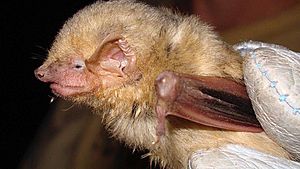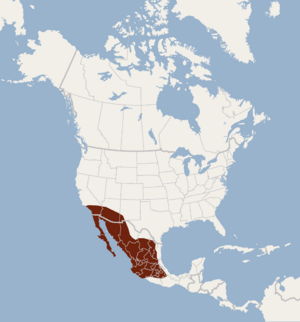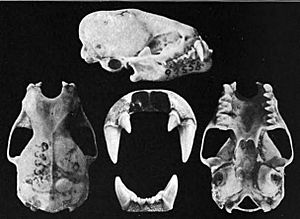Western yellow bat facts for kids
Quick facts for kids Western yellow bat |
|
|---|---|
 |
|
| Conservation status | |
| Scientific classification | |
| Genus: |
Lasiurus
|
| Species: |
xanthinus
|
 |
|
| Geographic range of the western yellow bat | |
| Synonyms | |
|
|
The western yellow bat (Lasiurus xanthinus) is a type of vesper bat, which is a common family of bats. You can find this bat in Mexico and the southwestern United States. These bats like to rest in trees such as Frémont's cottonwood, Arizona sycamore, and Arizona white oak. If they can, western yellow bats will also use the dead leaves around palm trees as a cozy place to roost.
Contents
Understanding the Western Yellow Bat's Name and History
How the Western Yellow Bat Got Its Name
This bat was first described in 1897 by a British zoologist named Oldfield Thomas. He called it a new subspecies of bat. At first, he listed it as a type of southern yellow bat. Its full scientific name was Dasypterus ega xanthinus.
Why Scientists Study Bat Names
In 2015, some scientists suggested that this bat and other yellow bats should be in their own group, called Dasypterus. However, other scientists think Dasypterus should stay as a smaller group within Lasiurus. In 1988, scientists decided it should be its own full species. They made this decision based on its genetics, which is like its unique DNA blueprint.
What "Xanthinus" Means
The word "xanthinus" in its scientific name comes from Ancient Greek. The word xanthos means "pertaining to yellow." This makes sense because of the bat's bright yellow fur!
Physical Features of the Western Yellow Bat
The western yellow bat is a small bat. However, it is a bit bigger than the southern yellow bat. Its fur is a bright, sunny yellow color. Each bat weighs about 16 g (0.56 oz), which is very light. Their forearm length is usually between 42–47 mm (1.7–1.9 in).
Understanding Bat Teeth
Like all mammals, bats have teeth. The western yellow bat has a special dental formula. This formula tells us how many teeth it has in its upper and lower jaws. It has 1.1.2.33.1.2.3 teeth, which means it has a total of 32 teeth.
Where the Western Yellow Bat Lives
Geographic Range
The western yellow bat lives in the Southwestern United States. This includes states like Arizona, California, and New Mexico. It also lives in many parts of Mexico. You can find it in West and Central Mexico, as well as in Baja California.
Preferred Homes
These bats prefer to live in areas where they can find the right trees for roosting. They often choose places with Frémont's cottonwood, Arizona sycamore, or Arizona white oak trees. They especially like palm trees because they can hide among the dead palm fronds.
Protecting the Western Yellow Bat
Conservation Status
As of 2017, the western yellow bat is considered a least-concern species by the IUCN. This means that scientists are not very worried about this bat becoming endangered right now.
Why It's a "Least Concern" Species
The western yellow bat is listed as "least concern" for several reasons:
- It lives across a very wide area.
- Scientists believe there are many of these bats in the wild.
- Many places where it lives are protected areas, like national parks.
- Its population is not expected to drop quickly in the near future.
See also
 In Spanish: Dasypterus xanthinus para niños
In Spanish: Dasypterus xanthinus para niños



